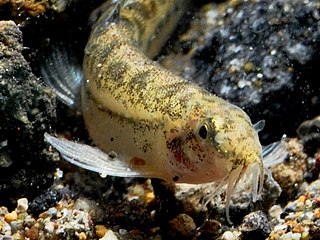
Hugh McCormick Smith, also H. M. Smith was an American ichthyologist and administrator in the United States Bureau of Fisheries.
The Küçük Menderes spined loach, Cobitis fahireae is a species of loach endemic to Turkey where it occurs in intermittent rivers.
Maurice Kottelat is a Swiss ichthyologist specializing in Eurasian freshwater fishes.
Schistura reidi is a species of ray-finned fish, a stone loach, in the genus Schistura. It occurs in the Salween basin in Mae Hong Son Province, Thailand, and probably in Myanmar too as the Salween forms the border between Myanmar and Thailand in this area. The specific name honors Earl D. Reid of the Division of Fishes at the United States National Museum.

Schistura waltoni is a species of ray-finned fish, a stone loach, in the genus Schistura. It is a species of in streams which have a moderate to fast current where it can be found in riffles, over gravel to rock beds. It is often recorded in small streams in forest, even where the water is very shallow. It occurs in the upper reaches the Chao Phraya watershed in Thailand in the rivers Mae Nam Ping, Mae Nam Wang and Mae Nam Yom. The specific name honours Joseph Walton a 19th Century contributor to the fish collection at the Academy of Natural Sciences of Philadelphia.
Yunnanilus nanpanjiangensis is a species of ray-finned fish, a stone loach, in the genus Yunnanilus. It is endemic to China and uts type locality is near Agang Town, Luoping County, Yunnan and the specific name refers to the Nanpanjiang River.
Oxynoemacheilus hamwii, the Orontes sportive loach, is a species of ray-finned fish in the genus Oxynoemacheilus. This species is found in the headwaters of the Orontes River but is now restricted to three streams in the Turkish part of the drainage, two joining the lower Orontes in Turket and the third flowing into the Afrin River in Syria, and has been extirpated from Syria. It was described as being very common in the late 20th century, but it is sensitive to pollution and requires clear, flowing streams over mud or gravel. The drainage of the Orontes is heavily used by humans and lower rainfall in the region caused by climate change may exacerbate the threat to this species by increasing the amount of water taken from the streams by humans and by lowering the water table.
Oxynoemacheilus theophilii is a species of stone loach native to Turkey and the island of Lesbos in Greece. This species occurs in streams and reaches a length of 6.6 centimetres (2.6 in) SL. It is found in the Büyük Menderes River and other streams in western Anatolia, Turkey, and the Evergetoulas Stream on the island of Lesbos, Greece. It can be found in the upper reaches of streams with clear, cold, flowing water where it hides among the stones of the stream bed. The stomach contents of a single female were found to consist of aquatic insect larvae. Water abstraction and the increased droughts caused by climate change are the main threats.
Oxynoemacheilus bergianus, the Kura sportive loach, is a species of ray-finned fish in the genus Oxynoemacheilus. This species is found in Lake Urumiyeh and Namak Lake basins in Iran, in the southern Caspian basin from Kura east to the Sefid-Rud drainage. It can also be found in the headwaters of Tigris in Turkey, Iraq and in Karoun, Iran as well as those of the Euphrates in Turkey and possibly in Syria and Iraq. It lives in fast flowing streams and rivers with gravel and rocky substrates and does not tolerate impoundments, dam construction having been identified as a major potential threat to this species.
Triplophysa alexandrae is a species of stone loach in the genus Triplophysa endemic to Sichuan, China.
Triplophysa arnoldii is a species of stone loach in the genus Triplophysa. It is endemic to Mongolia. It grows to 7 cm (2.8 in) SL.
Triplophysa farwelli is a species of stone loach in the genus Triplophysa. It is found in Iran and the Helmand River drainage in Afghanistan.

The Tibetan stone loach is a species of ray-finned fish in the family Nemacheilidae. The specific name is sometimes spelled stoliczkae but the original spelling used by Steindachner is stoličkai. It is found in southern and central Asia.

Lepidocephalichthys hasselti is a species of cobitid loach native to southeastern Asia and western Indonesia. This species reaches a length of 45 millimetres (1.8 in) TL.
Oxynoemacheilus atili, the Lake Beyşehir loach, is a species of stone loach from the genus Oxynoemacheilus. It is endemic to Turkey being found only in the drainage basin of Lake Beyşehir in Central Anatolia, where it occurs in all the streams and in the Manavgat drainage in Mediterranean basin.
Oxynoemacheilus kaynaki, the medil loach, is a species of stome loach which is found in the Göksu, a right hand tributary of the Euphrates in southeast Anatolia, Turkey.
Oxynoemacheilus mesudae, the Işıklı loach, is a species of stone loach from the genus Oxynoemacheilus. It is endemic to the Lake Işıklı basin in central Anatolia, Turkey where it is known from four springs.
Oxynoemacheilus tongiorgii is a species of stone loach from the genus Oxynoemacheilus. It was found in a spring near the town of Darab in the Kul River basin of Iran. It has only been recorded once.
Oxynoemacheilus shehabi is a species of stone loach from the upper Orontes in southern Syria.
Triplophysa bellibarus is a species of stone loach in the genus Triplophysa.




